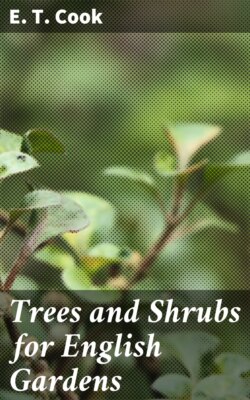Читать книгу Trees and Shrubs for English Gardens - E. T. Cook - Страница 20
На сайте Литреса книга снята с продажи.
A Flower Garden in Winter
ОглавлениеTable of Contents
"It is possible to make a new feature in gardens by setting apart a piece of ground exclusively for the cultivation of trees, shrubs, and bulbs—in short, any plants that flower or are bright with fruit or bark between, say, the beginning of November and the end of February. One might term it 'an outdoor winter garden.' For the purpose there would be required a well-drained piece of ground, the soil of which was fertile and open. The situation should be fully exposed to the south and west, but guarded well on the north and east sides by a thick belt of evergreen trees and shrubs. The shelter would be still more complete if the site sloped rather steeply to the south-west. Such shelter would be welcome, not only to the plants that grew there, but to those who might visit and tend them. Some of the more noteworthy trees and shrubs with ornamental barks I have already mentioned. Plants that carry their fruit into winter might be included, such as the Hollies, especially the yellow-berried Holly; Cratægus Crus-Galli and C. cordata; Cotoneaster rotundifolia, which is the best of all the Cotoneasters, and frequently carries its bright-scarlet berries till March; and Hippophaë rhamnoides, the Sea Buckthorn, whose orange-coloured fruits are borne in such profusion and retain their colour till past Christmas if the frosts are not too severe. The scarlet-fruited Skimmia japonica and its varieties are very ornamental during the winter months, but of these (as well as the Hippophaë) it is necessary to grow male and female plants together. Groups of variegated evergreens would not only help to give shelter and warmth, but would also add to the brightness of the garden. The best of them are the golden and silver variegated Elæagnuses, the Hollies of a similar character, and the best of the Aucubas, of which there are now some very fine forms; the female plants are also very ornamental as fruit-bearers. Pinus sylvestris aurea, a variety of the Scotch Pine that turns golden in winter but is green at other seasons, and Cupressus macrocarpa lutea are the two best Conifers of their class. Many of the variegated Conifers lose most or all of their colour as autumn and winter approach.
ULMUS ALATA.
"With regard to the trees and shrubs that bear flowers between November and February, the number is not, of course, great; still, they constitute a group that is larger, perhaps, than is generally supposed. The following list, which comprises all that I can call to mind, may be useful even to those who would not intend to bring them together in one spot. Some country houses are only occupied during the shooting and hunting seasons, and these winter-flowering plants are of especial value in such places. The tree or bush Ivies are very beautiful, and may be had in great variety, such as yellow berried, palmata aurea, rhomboidea ovata, and amurensis."
| November |
| Arbutus hybrida. |
| ,, Unedo and vars. |
| Daphne Mezereum grandiflora. |
| Elæagnus glabra, macrophylla, and pungens (all delightfully fragrant). |
| Hamamelis virginica. |
| Jasminum nudiflorum. |
| Lonicera fragrantissima. |
| ,, Standishii. |
| December and January |
| Chimonanthus fragrans. |
| Clematis calycina. |
| Cratægus monogyna præcox (Glastonbury Thorn). |
| Erica mediterranea hybrida. |
| ,, carnea. |
| ,, ,, alba. |
| Garrya elliptica. |
| Viburnum Tinus. |
| February and early March |
| Berberis japonica. |
| ,, nepalensis. |
| Cornus Mas. |
| Corylopsis spicata. |
| Daphne blagayana. |
| ,, Laureola and var. purpurea |
| ,, Mezereum. |
| ,, ,, var. alba. |
| ,, oleoides. |
| Erica mediterranea. |
| Hamamelis arborea. |
| ,, japonica. |
| ,, mollis. |
| ,, zuccariniana. |
| Prunus davidiana (pink and white forms). |
| ,, Amygdalus persicoides. |
| Populus tremuloides pendula. |
| Parrotia persica. |
| Pyrus japonica. |
| Rhododendron altaclarense. |
| ,, dauricum. |
| ,, nobleanum. |
| ,, præcox. |
